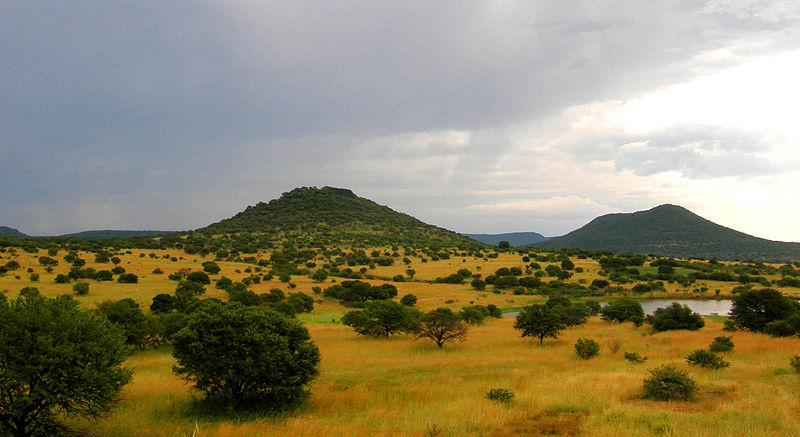Adaptation
The dik-diks have acquired many adaptations that allow it to
have increased chances of survival. Africa can be a very
challenging place for animals to survive, especially in the arid
and semi-arid climates. There is limited food and water, so
organisms must adapt to the environment to maximize what they do
get.
The dik-diks are browsers and they consume a diet throughout the
-wiki%20(640x427).jpg) year of consistently high quality plant material. The dik-dik
mostly consumes plants that are easy to ferment and digest, and
are also high in fats and protein. This diet requires a foregut
that is efficient in the absorption and fermentation of the
plant material and comparatively quick (Moloiy et al., 1988).
year of consistently high quality plant material. The dik-dik
mostly consumes plants that are easy to ferment and digest, and
are also high in fats and protein. This diet requires a foregut
that is efficient in the absorption and fermentation of the
plant material and comparatively quick (Moloiy et al., 1988).
Figure 1. Madoqua kirkii in Etosha National Park, Namibia. The pre-orbital glands are evident in this photo.
As A result of living in such a dry environment,
dik-diks receive very
little water from their food. This leads to a very low daily
water uptake and exchange (Moloiy et al., 1988). As a result of such a low water intake, the dik-dik have made some
adaptations in order to survive their hot, dry environment. The
dik-dik is very efficient in_-Tarangire_National_Park_-Tanzania-wiki.jpg) how they use their water and they
use multiple mechanisms to do so. They can conserve water
by licking the dew off of their noses, dew off of vegetation,
concentrate and restrict urine output, panting, and resting in
the shade during the day when it is hot (Kingswood & Kumamoto,
1997). They reduce the volume
of urine they produce, many times decreasing usage by 50% which
can save 20-100 grams of water per day. The urine is also
extremely concentrated in order to decrease water loss.
They can also excrete drier feces for the same reason, saving
10-20 more grams daily. Dik-diks are capable of active sweating
in order to keep cooler in the sun, but if they do not sweat and
they decrease their water lost by evaporation,
they can save 70-100 grams of water every day (Moloiy et al.,
1988).
how they use their water and they
use multiple mechanisms to do so. They can conserve water
by licking the dew off of their noses, dew off of vegetation,
concentrate and restrict urine output, panting, and resting in
the shade during the day when it is hot (Kingswood & Kumamoto,
1997). They reduce the volume
of urine they produce, many times decreasing usage by 50% which
can save 20-100 grams of water per day. The urine is also
extremely concentrated in order to decrease water loss.
They can also excrete drier feces for the same reason, saving
10-20 more grams daily. Dik-diks are capable of active sweating
in order to keep cooler in the sun, but if they do not sweat and
they decrease their water lost by evaporation,
they can save 70-100 grams of water every day (Moloiy et al.,
1988).
Figure 2. Male dik-dik in the
Tarangire National Park
The dik-dik needs to be concerned with regulation of body
temperature. Three different mechanisms for this have been
observed by the dik-dik: labile temperature, thermopanting, and
active sweating (Moloiy et al., 1988). Mechanisms such as these
are necessary to avoid excess insulation, dehydration, and a
dependency on drinking water. The dik-dik adapted these
mechanisms in order to survive in their natural environment
(Kamau & Maloiy, 1985). Researchers predicted that, for their
body mass, dik-diks should have a metabolic rate much higher
than what was actually found. The actual value is 20% lower than
that predicted. This low of a metabolic rate is a physiological
adaptation to the hot environment that the dik-dik lives in
(Moloiy et al., 1988).
.jpg) Figure 3. Dik-dik in motion. Photographed by Mickey Burwell
and found on Bill & Sue-on Hillman's ERBzine's
Tarzan's Africa photo gallery.
Figure 3. Dik-dik in motion. Photographed by Mickey Burwell
and found on Bill & Sue-on Hillman's ERBzine's
Tarzan's Africa photo gallery.
Dik-dis have very large, dark eyes which take up a considerable portion of their miniature head. Underneath the inner corner of each eye is a large black spot which are called pre-orbital glands. These glands produce and secrete a dark tacky liquid that is used for marking their home ranges and territory (Moloiy et al., 1988). Another distinguishing body part of the dik-dik would be the snout. The proboscis is very long, and this does benefit the animal. It allows venous blood to cool through evaporation from the mucous membrane into the nasal cavity for normal breathing (Scheibe, 1999). This can also happen during nasal panting when there is a lot of stress (Kingswood & Kumamoto, 1997).
